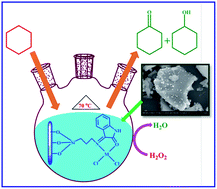Highly dispersed Cu(ii), Co(ii) and Ni(ii) catalysts covalently immobilized on imine-modified silica for cyclohexane oxidation with hydrogen peroxide†
Abstract
This paper describes the synthesis of Cu(II), Co(II) and Ni(II) catalysts immobilized on imine-functionalized silica gel through a 3-aminopropyltriethoxysilane linker. The synthesized catalysts were characterized by spectroscopic techniques, namely EDS, FTIR, UV-Vis, 29Si MAS NMR, powder XRD and ESR spectroscopy. These analytical methods evidently confirmed the formation of silica-supported catalysts. Thermal properties of catalysts were studied between 30 and 800 °C by thermogravimetric-differential thermal gravimetric (TG-DTG) analysis. The surface roughness of the silica gel was increased upon modification but without losing its lumpy shape, as evidenced by SEM investigation. Magnified SEM and AFM images both suggested the high dispersive nature of the catalysts. Cyclohexane was successfully converted into cyclohexanol and cyclohexanone by the catalysts with the aid of hydrogen peroxide (oxidant). Comparatively, Cu(II) catalyst exhibited better cyclohexane conversion than the other two catalysts. The reusable nature of the catalysts was established by performing five consecutive catalytic runs with Cu(II) catalyst. Comparatively, the present reported catalytic systems were simple, reusable and effective models for higher cyclohexane conversion with better product selectivity.


 Please wait while we load your content...
Please wait while we load your content...